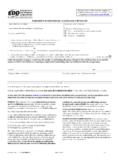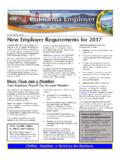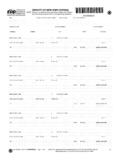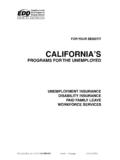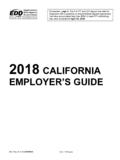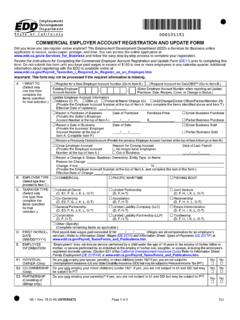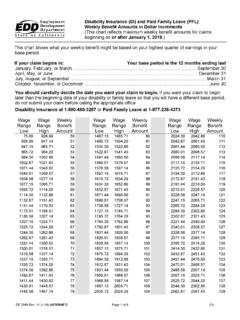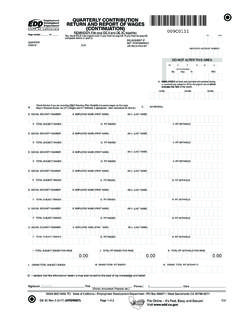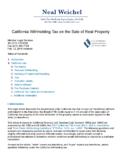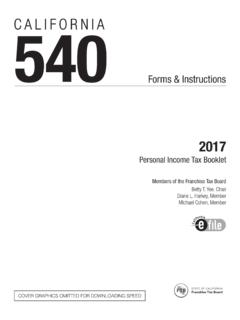Transcription of CALIFORNIA WITHHOLDING SCHEDULES FOR 2019
1 CALIFORNIAWITHHOLDING. CALIFORNIA WITHHOLDINGSCHEDULES. SCHEDULES FOR. FOR 2019. 2019. CALIFORNIA provides two methods for determining the amount of wages and salaries to be withheld for state personal income tax: METHOD A - WAGE BRACKET TABLE METHOD (Limited to wages/salaries less than $1 million). METHOD B - EXACT CALCULATION METHOD. METHOD A provides a quick and easy way to select the appropriate WITHHOLDING amount, based on the payroll period, filing status, and number of WITHHOLDING allowances (regular and additional) if claimed. The STANDARD DEDUCTION. and EXEMPTION ALLOWANCE CREDIT are already included in the wage bracket tables. Even though this method involves fewer computations than Method B, it cannot be used with your computer in determining amounts to be withheld. METHOD B may be used to calculate WITHHOLDING amounts either manually or by computer. This method will give an exact amount of tax to withhold. To use this method, you must enter the payroll period, filing status, number of WITHHOLDING allowances, standard deduction, and exemption allowance credit amounts.
2 These amounts are included in TABLES 1. through 5 of the EXACT CALCULATION section. If there are any questions concerning the operation/methodology of Method B for computer software, you may contact: Franchise Tax Board, Statistical Research and Modeling Section 516, Mail Stop A-351. PO Box 942840, Sacramento, CA 94240. SPECIAL NOTE FOR MARRIED EMPLOYEES WITH EMPLOYED SPOUSES: To avoid underwithholding of state income tax liability we recommend that you use one of the following options: Single filing status to compute WITHHOLDING amounts for the employee and spouse; or withhold an additional flat amount of tax. Instructions for additional WITHHOLDING allowances for estimated deductions: All additional allowances for ESTIMATED DEDUCTIONS that are claimed on a DE 4 must be used to reduce the amount of salaries & wages subject to WITHHOLDING by using steps 1 and 2 shown below. If the Form W-4 is used for CALIFORNIA WITHHOLDING purposes, all additional allowances for ESTIMATED DEDUCTIONS claimed must be treated as regular WITHHOLDING allowances; unless the employee requests in writing that they be treated in accordance with the following: 1.
3 Subtract the employee's estimated deduction allowance shown in the "TABLE 2 - ESTIMATED DEDUCTION TABLE". from the gross wages subject to WITHHOLDING ; and 2. Compute the tax to be withheld using: METHOD A - WAGE BRACKET TABLE METHOD; or METHOD B - EXACT CALCULATION METHOD. If the DE 4 is used for CALIFORNIA WITHHOLDING purposes, compute the tax to be deducted and withheld based on the total number of regular WITHHOLDING allowances claimed on line 1 of the DE 4. If the Form W-4 is used for CALIFORNIA WITHHOLDING purposes, compute the tax to be deducted and withheld based on the total number of WITHHOLDING allowances claimed on line 5 of Form W-4; minus the number of additional allowances for estimated deductions claimed. If Form W-4 does not separately identify the number of additional allowances for estimated deductions, the employee's request must specify the number claimed. The employee's request will remain in effect until the employee terminates it by furnishing a signed written notice or by furnishing a DE 4.
4 Employers may require employees to file a DE 4 when they wish to use additional allowances for estimated deductions to reduce the amount of wages subject to WITHHOLDING . Taxpayer Assistance Center 888-745-3886. 2019 WITHHOLDING SCHEDULES - Method B (INTERNET) Page 01 of 10. CALIFORNIA WITHHOLDING . CALIFORNIA SCHEDULES . WITHHOLDING SCHEDULES FOR. FOR 2019. 2019. METHOD B - EXACT CALCULATION METHOD. This method is based upon applying a given percentage to the wages (after deductions) which fall within a taxable income class, adding to this product the accumulated tax for all lower tax brackets; and then subtracting a tax credit based upon the number of allowances claimed on the Employee's WITHHOLDING Allowance Certificate (Form W-4 or DE 4). This method also takes into consideration the special treatment of additional allowances for estimated deductions. The steps in computing the amount of tax to be withheld are as follows: Step 1 Determine if the employee's gross wages are less than, or equal to, the amount shown in TABLE 1 - LOW INCOME EXEMPTION TABLE.
5 If so, no income tax is required to be withheld. Step 2 If the employee claims any additional WITHHOLDING allowances for estimated deductions on a DE 4 form, subtract the amount shown in TABLE 2 - ESTIMATED DEDUCTION TABLE from the gross wages. Step 3 Subtract the standard deduction amount shown in TABLE 3 - STANDARD DEDUCTION TABLE to arrive at the employee's taxable income. Step 4 Use "TABLE 5 - TAX RATE TABLE for the payroll period and marital status to find the applicable line on which the taxable income is located. Perform the indicated calculations to arrive at the computed tax liability. Step 5 Subtract the tax credit shown in TABLE 4 - EXEMPTION ALLOWANCE TABLE * from the computed tax liability to arrive at the amount of tax to be withheld. * If the employee uses additional allowances claimed for estimated deductions, such allowances MUST NOT be used in the determination of tax credits to be subtracted. EXAMPLE A: Weekly earnings of $210, single, and claiming one WITHHOLDING allowance on form W-4 or DE 4.
6 Step 1 Earnings for the weekly payroll period are LESS than the amount shown in "TABLE 1 - LOW INCOME. EXEMPTION TABLE" ($280); therefore, no income tax is to be withheld. EXAMPLE B: Biweekly earnings of $1,250, married, and claiming three WITHHOLDING allowances, one of which is for estimated deductions. Step 1 Earnings for the biweekly payroll period are GREATER than the amount shown in "TABLE 1 - LOW. INCOME EXEMPTION TABLE" ($1,121); therefore, income tax should be withheld. Step 2 Earnings for biweekly payroll $1, Subtract amount from "TABLE 2 - ESTIMATED DEDUCTION TABLE.".. Salaries and wages subject to $1, Step 3 Subtract amount from "TABLE 3 - STANDARD DEDUCTION TABLE.".. Taxable $ Step 4 Tax computation from "TABLE 5 - TAX RATE TABLE: . Entry covering $873 (over $656 but not over $1,560). amount over $656 (.022 x [$873 $656]).. $ Plus the marginal + Computed Step 5 Subtract amount from "TABLE 4 - EXEMPTION ALLOWANCE TABLE.". for two regular WITHHOLDING .. Net amount of tax to be $ NOTE: Table 5 provides a method comparable to the federal alternative method for percentage calculation of WITHHOLDING .
7 This method is a minor simplification of the exact calculation method described above in that the tax rate applies to the total taxable income with the excess amount subtracted. Taxpayer Assistance Center 888-745-3886. 2019 WITHHOLDING SCHEDULES - Method B (INTERNET) Page 02 of 10. CALIFORNIA WITHHOLDING . CALIFORNIA SCHEDULES . WITHHOLDING SCHEDULES FOR. FOR 2019. 2019. METHOD B - EXACT CALCULATION METHOD (CONTINUED). EXAMPLE C: Monthly earnings of $4,100 married, and claiming five WITHHOLDING allowances on form W-4 or DE 4. Step 1 Earnings for the monthly payroll period are GREATER than the amount shown in "TABLE 1 - LOW. INCOME EXEMPTION TABLE" ($2, ); therefore, income tax should be withheld. Earnings for monthly payroll $4, Step 2 Not applicable - no estimated deduction allowance claimed. Step 3 Subtract amount from "TABLE 3 - STANDARD DEDUCTION TABLE . Taxable $3, Step 4 Tax computation from "TABLE 5 - TAX RATE TABLE: . Entry covering $3,366 (over $1,424 but not over $3,376).
8 Of amount over $1,424 (.022 x [$3,366 - $1,424]). $ Plus marginal tax + Computed $ Step 5 Subtract amount from "TABLE 4 EXEMPTION ALLOWANCE TABLE" for five regular WITHHOLDING Net amount of tax to be $ EXAMPLE D: Weekly earnings of $800, unmarried head of household, three WITHHOLDING allowances on form W-4 or DE 4. Step 1 Earnings for the weekly payroll period are GREATER than the amount shown in "TABLE 1 - LOW. INCOME EXEMPTION TABLE" ($561); therefore, income tax should be withheld. Earnings for weekly payroll $ Step 2 Not applicable - no estimated deduction allowance claimed. Step 3 Subtract amount from "TABLE 3 - STANDARD DEDUCTION TABLE".. Taxable income .. $ Step 4 Tax computation from "TABLE 5 - TAX RATE TABLE: . Entry covering $631 (over $329 but not over $779). of amount over $329 (.022 x [$631 - $329]). $ Plus marginal tax + Computed $ Step 5 Subtract amount from "TABLE 4 - EXEMPTION ALLOWANCE TABLE" for three regular WITHHOLDING Net amount of tax to be $ EXAMPLE E: Semi-monthly earnings of $1,800, married, and claiming four allowances on form W-4 or DE 4.
9 Step 1 Earnings for the semi-monthly payroll period are GREATER than the amount shown in "TABLE 1 - LOW. INCOME EXEMPTION TABLE" ($1,214); therefore, income tax should be withheld. Annualized wages and salary (24 x $1,800).. $43, Step 2 Not applicable - no estimated deduction allowance claimed. Step 3 Subtract amount from "TABLE 3 - STANDARD DEDUCTION TABLE.".. -8, Taxable $34, Step 4 Tax computation from TABLE 5 - TAX RATE TABLE: . Entry covering $34,392 (over $17,088 but not over $40,510). of amount over $34,392 (.022 x [$34,392 - $17,088]).. $ Plus marginal tax + Computed annual $ Step 5 Subtract amount from "TABLE 4 - EXEMPTION ALLOWANCE TABLE" for four regular WITHHOLDING Annual amount of tax to be $ Divide by number of payroll periods in year (24).. $ NOTE: Employers may determine the amount of income tax to be withheld for an annual payroll period and prorate the tax back to the payroll period. This method may be useful to employers who have employees being paid for more than one payroll period and want to conserve computer memory by storing only the annual tax rates, wage brackets, deduction values, and tax credits.
10 Taxpayer Assistance Center 888-745-3886. 2019 WITHHOLDING SCHEDULES - Method B (INTERNET) Page 03 of 10. CALIFORNIA WITHHOLDING SCHEDULES FOR 2019. CALIFORNIA WITHHOLDING SCHEDULES FOR 2019. METHOD B - EXACT CALCULATION METHOD (CONTINUED). EXAMPLE F: Annual earnings of $45,000, monthly pay period, married, and claiming four allowances on form W-4 or DE 4. Step 1 Earnings for the annual payroll period are GREATER than the amount shown in "TABLE 1 - LOW. INCOME EXEMPTION TABLE" ($29,146); therefore, income tax should be withheld. Annualized wages and/or monthly salary (12 x $3,750).. $45, Step 2 Not applicable - no estimated deduction allowance claimed. Step 3 Subtract amount from "TABLE 3 - STANDARD DEDUCTION TABLE.".. -8, Taxable $36, Step 4 Tax computation from TABLE 5 - TAX RATE TABLE: . Entry covering $36,198 (over $17,088 but not over $40,510). of amount over $17,088 (.022 x [$36,198 - $17,088]).. $ Plus marginal tax + Computed annual $ Step 5 Subtract amount from "TABLE 4 - EXEMPTION ALLOWANCE TABLE" for four regular WITHHOLDING Annual amount of tax to be $ Divide by number of payroll periods in year (12).
